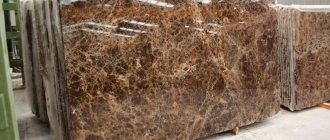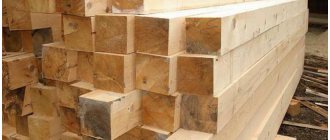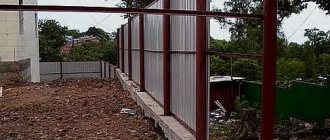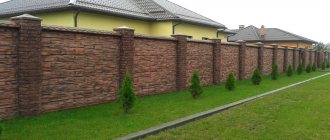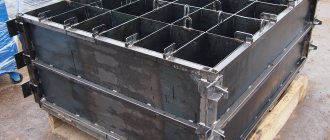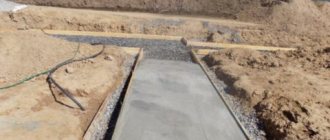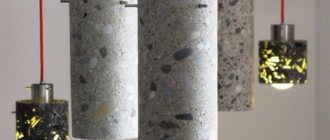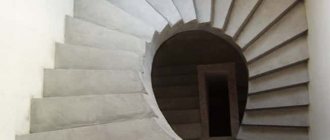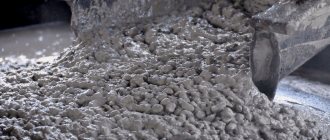Varieties
Before installing such a structure on a summer cottage, you need to decide what it will look like. There are several types of such fences, so there is plenty to choose from.
Fence
Such a fence resembles a section of several slabs. It is permissible to place decorative elements on top of the concrete structure.
The design can be either monolithic or ventilated. The latter option is possible if a small distance is left between the plates. such a fence is in demand among summer residents, because sections are compact and lightweight. There are also no difficulties with installation: you just need to insert the fence segments into the grooves of the support posts.
Often the coating is made to resemble natural stone, wood and other materials.
Monolithic product
This design is the most durable. For installation you will need to use a strip or column foundation.
Attention!
A monolithic fence is a completely solid slab of reinforced concrete. They come in smooth and decorated designs.
Properties of such fences:
- the weight varies between 0.5-4 tons, so installation is impossible without special equipment;
- such a structure would be appropriate for large areas.
Smooth fences are suitable for warehouses or industrial areas. For house fencing, it is better to give preference to beautiful slabs with decor or simply painted ones.
Block fence
This structure is assembled from blocks, the fastening of which is carried out with cement mortar. Often, hollow building materials are used for such fences, but if a structure of increased strength is needed, it is better to choose monolithic elements. In the first case, the presence of voids allows the contraction to be strengthened before pouring concrete. The fence should stand on a foundation that is twice the width of the block. There is no need for support posts.
You can decorate the fence with tiles or plaster - the choice depends on the exterior of the main building. The finished monolithic product can easily be confused with brickwork. Installation on site is quick.
Attention!
The fence can be made to any height - the only restrictions are the desires of the dacha owner.
This type of contraction is distinguished by its reliability, unusual design, and ease of installation.
Self-standing concrete fence
To build a fence, you need monolithic reinforced concrete slabs. Their difference is in the powerful base installed on the ground. In some models it is permissible to replace it with spikes. They will need to be inserted into ready-made concrete holes.
A foundation for a self-standing fence is not required. It is used for the purpose of fencing the area for some time. If necessary, you can transfer it to another location. If you decide to apply a design to the fence, then this can only be done from the outside.
Double-sided concrete fence
The structure is stylish thanks to the double-sided decor, but at the same time reliable. Grad, for which concrete panels were used, can be made to look like brick, slate, stone, etc. This diversity is ensured by modern design trends.
New equipment and high quality polyurethane molds are used to create slabs. Therefore, their structure is identical to natural material.
The length of the slab is 5 m, and the height is approximately 2.5 m. The thickness is slightly more than 12 cm. All elements of the fence are massive, weighing over 3 tons.
Installation takes place using pillar blocks, so there is no need for a foundation. In addition, the fence will withstand even a truck collision.
Modular structures with pressed concrete supports
This type of fence appeared relatively recently, but has already become popular. The modules allow you to build fences of various shapes. To do this you need to prepare:
- pillar;
- base slab;
- sketches of drawings for a wooden, metal block or made of other material.
The design and color of the fence can be any.
How to make a concrete fence with your own hands
Do you want to live like behind a stone wall? Just build a concrete fence and your dream will come true; construction will also cost much less than a stone one. Reinforced concrete products combine two opposing characteristics of a permanent fencing - durable construction and aesthetic appearance. You can see this for yourself by looking at photos of concrete fences.
Advantages of concrete fences
Concrete fencing has many advantages, which is why they are increasingly appearing both in urban areas and in suburban areas:
- exceptional strength and durability,
- the fence does not deteriorate over time, it is not exposed to natural factors,
- a solid concrete fence has excellent sound insulation properties,
- if necessary, the fence can be made without joints and gaps,
- the concrete surface can be easily finished with any finishing material,
- concrete is the most economical material of all capital ones.
Relative disadvantages include the large weight of the structures.
The construction of such a fence will require considerable labor and the mandatory installation of a foundation.
Concrete fences differ in their manufacturing technology and functional purpose.
Monolithic fences
This type of fence is the most durable and strong. It requires a solid or columnar foundation. The fence itself consists of solid reinforced concrete slabs, firmly connected to pillars. Monolithic slabs can be smooth, corrugated or decorative.
Stacked (sectional) fences
Stacked, or sectional, are called fencing, each section of which consists of several slabs or panels. The slabs can have different textures and differ in decorative design. The posts for a stacked fence have grooves on the sides into which the panels fit.
The main difficulty in constructing a sectional concrete fence is the precise installation of the posts.
The distance between them should correspond to the length of the panel. Otherwise, the panels will not stay in the grooves or will not fit there at all. As a rule, a strong foundation is made under the pillars of such a fence so that they do not warp after the phase of freezing and thawing of the soil. The convenience of a stacked fence is manifested in the assembly of panels into the grooves of concrete fence posts. Each of the parts is light in weight; two or three people are enough to carry and stack it. Top panels that are installed at a height of more than a meter are usually made openwork. Due to the numerous holes they become much lighter and easier to install.
Concrete block fence
Block fences are assembled from individual solid or hollow concrete blocks, fastening them together with cement mortar. This type of structure resembles brickwork. A fence made of blocks needs to be finished with decorative plaster or tiles with imitation stone.
A concrete block fence does not require posts between the individual sections, but masonry skills are required for masonry.
Decorative concrete fencing
Decorative fencing is made in a wide variety of styles and colors. With the help of decorative concrete casting, craftsmen create durable and aesthetic compositions that combine perfectly with other materials - wood, openwork forged metal, natural stone. Manufacturers offer many options made to resemble brickwork and stone of various textures. Concrete casting successfully imitates a balustrade and even wooden lining. Decorative concrete fences are in great demand when fencing private property, where solidity and respectability are primarily required.
How to make a concrete fence with your own hands
To install a concrete fence with your own hands, you will need tools and building materials:
- steel reinforcement 4 mm for the fence and 8 mm for the posts,
- crushed stone with a fraction size of 2–6 cm,
- washed river sand,
- cement grade no less than M500,
- concrete casting molds,
- plasticizer,
- concrete mixer,
- vibrating table
You can buy a vibration table ready-made or make it yourself. To make it yourself, a frame is welded from a metal corner and a vibration motor is mounted on it.
It is possible to make concrete panels without the use of vibration equipment, but their quality will be much lower.
Concrete panel casting technology
Crushed stone is loaded into a concrete mixer, filled with water and washed to remove dust and impurities. Then the water is drained and sand, cement and water are loaded. The exact proportions of the solution for the selected brand of cement are usually written on the packaging.
Currently, there is a wide range of plasticizers on sale - special additives for imparting certain properties to concrete or for accelerating (slowing down) the setting of the solution. When making a concrete fence, plasticizers are used to give the solution mobility, non-delamination and additional strength.
The casting mold is placed on a vibrating table, lubricated with mineral oil to prevent the solution from sticking, and the fittings are prepared. The reinforcement scheme must be thought out in advance, based on the characteristics of the shape. Ideally, the reinforcement should extend across the entire thickness of the panel without protruding on the surface.
The mold is filled to half the volume and the vibrator is turned on. Then the reinforcement is laid, the solution is added to the top of the form and the concrete is compacted again with a vibrator.
At the stage of pouring the form, fasteners should be provided to connect the panel with other parts of the fence - above or below the panels or posts.
After the solution has dried, stripping is carried out - separating the finished panel from the mold. Then the product is rubbed manually or with machines to a standard appearance, the form is cleaned of concrete residues and prepared for the next pour.
Installation of intersection poles
In marked places, they dig holes with a diameter of about 50 cm. Its depth should be no less than the depth of soil freezing in the given area. The bottom of the pit is compacted, covered with a 10–15 cm layer of sand and compacted again. Then the pillar is installed strictly vertically, secured in this position and filled with concrete mortar to the ground level.
To completely harden the foundation, it is necessary to wait two weeks.
Assembly of the entire structure
The finished panels are placed in the grooves of the pillars or the reinforcement of each panel and pillars, previously brought to the surface, is welded together.
At this stage, the installation work of the reinforced concrete fence can be considered complete. The finished structure is additionally finished with decorative materials - plaster, facade paint for concrete, tiles. Be sure to paint all welded parts with weather-resistant paint to prevent corrosion.
Dimensions and design
Often, fence slabs have the following dimensions: width - 2 m, height - 0.5 m. If there are gaps in the design of the facade, then the length should be 2.06 m. In this case, the length can vary from 65 cm to 2.6 m The thickness should not exceed 8 cm. With such characteristics, it will be impossible to see from the street what is happening on the territory of the summer cottage.
Don’t forget about support pillars with a standard section of 15x15 cm. In other words, when installing 10 slabs 2.06 m long, the length of the fence will be 20.75 m. These figures were obtained taking into account the first and last support pillar.
Attention!
If a free-standing fence is installed on the site, it is important to take into account their height (3 m) and the weight of each section (the weight of one is 2.5 tons).
If you need to decorate a concrete structure, an imitation of natural stone is often used for this. But often customers make a choice in favor of wood, brick, etc.
Also suitable for decoration:
- coloring;
- combination with forged elements;
- tiles imitating different materials;
- drawings;
- imitation of climbing plants.
Complex fences may contain different blocks. It will be almost impossible to determine exactly what the fence is made of if you take a responsible approach to choosing the design.
Overview of types of structures and their installation
There are several types of concrete fences, these are:
- Block;
- Monolithic;
- Monolithic self-standing;
- typesetting;
- Decorative
However, this classification is not complete. Each of these types has its own subtypes, depending on production technology, design, purpose, and installation method. Let us briefly consider the characteristics and installation features of each type of structure.
Monolithic fence structures
This type is the most durable of all. It also has a fairly high weight, which directly affects the features of its installation.
If we talk about ready-made monolithic sections, then the main prerequisite is the construction of a strip or columnar foundation, without which some other types of concrete structures can completely do without.
Monolithic concrete fence
The installation of such slabs begins with the construction of the foundation.
If the base is tape, then the order of work is as follows:
- First of all, they dig a trench and install the formwork. It must be level, since any deviations can result in the fence tilting, that is, it may not stand level. The trench, depending on the type of soil, should reach a depth of 60 to 100 cm.
- To further strengthen the structure, reinforcement is laid out.
- Next, they move on to pouring concrete on the ground part.
If you decide to build a columnar foundation, then brief instructions for its construction look like this:
- First, wells are made at a distance of about 1.5-2 meters and a depth of about 1 meter along the entire perimeter of the site. A small amount of crushed stone or sand is poured into them.
- Next, asbestos-cement pipes are installed into which concrete is poured. The outside is covered with rubble.
Note! For better fixation, the pipes after pouring are slightly raised to allow the concrete to spread. Then they put it in place and press it down. As a result, a kind of foundation is formed for the pillars on which they stand. Next, mandatory reinforcement and filling are carried out.
In addition to asbestos-cement pillars, you can also use concrete fence supports. They are mounted according to the same principle. After completing their installation, you should begin installing the slabs themselves. In this case, a specialized fastening element or a cement solution is used at the joints.
It is not possible to install monolithic concrete products yourself. Firstly, they are very heavy, and secondly, installation of this structure requires professionalism. It is necessary to involve construction equipment.
Fence installation
It is also worth paying attention to the monolithic fence, which is cast directly on the site using formwork. In this case, the installation method is the simplest, since preliminary pouring of the foundation is not required.
Work begins with fixing the support pillars. Again, wells are drilled with a diameter of 0.2 meters and a depth of at least 1 meter, into which pipes are installed plumb. Next, the wells are subjected to concreting.
Between the pillars along the entire perimeter, depressions are made, which are covered with crushed stone or sand. Reinforcement is sometimes welded to pipes along their entire length to ensure the strength of the fence sections. Subsequently, formwork is installed under the fence and filled with concrete.
Note! After pouring, it is necessary to compact the concrete by bayoneting.
The final stage is finishing the fence.
Eurofence concept
In fact, this type of fence is the same concrete fence, distinguished by high external qualities and some production features.
Euro fence concrete
Euro-concrete fences have become widespread precisely due to the variety of colors and shapes. The consumer can choose a variety of textures, for example, stone or brick. Combined options with decorations made of natural stone or metal are also available. They consist of support pillars that act as connecting elements with concrete panels or sections.
Eurofences come in two types: one-sided and two-sided. As the name suggests, one-sided fences have a pattern or texture only on the face.
This option is very relevant when the appearance of the reverse side is not so important. Double-sided concrete euro fences are decorated on both sides. Most often, the thickness of the structure increases somewhat due to this.
Their significant disadvantage is their fairly high price. Such a fence may be cheaper than a brick one, however, if we compare standard types of undecorated concrete fences, then the Euro fence loses in this regard.
Installation is extremely simple, which allows you to assemble the fence yourself. First, they mark the territory and dig in pillars by analogy with the technology described above.
To secure heavy sections, you will need a strip or column foundation, as well as the use of a construction crane to lift them. The final stage will be laying the slabs into the grooves of the pillars.
Installation of eurofence
Installation of independent structures, fixing slabs to glasses
When installing self-standing fences, a foundation is not required - due to the presence of a sufficiently wide base, due to which the slabs take a vertical position.
Self-standing concrete fence
Installation proceeds as follows:
- First, dig a shallow trench around the entire perimeter of the site. The depth should be about 10-15 cm, and the width should be about 20-25 cm more than the base of the slab;
- Next, a cushion of sand and crushed stone is installed, which is carefully compacted;
- With the help of a construction crane, the slabs are placed.
It would be worth mentioning another option for installing concrete slabs, which does not require a foundation. In accordance with it, specialized concrete fence glasses are placed in the ground, which hold the slabs in the desired position after they are fixed on spikes.
Glass for fence
Installation of concrete on glasses
The above process includes the following steps:
- They begin work by marking the territory, stretching a construction thread around the perimeter;
- The next step will be to install the glasses at the distance necessary for further fixation of the slabs (depending on the size of the slab);
- Using construction equipment, the slabs are mounted in the grooves of the glasses.
Note! Before installation, to avoid deformation of the slabs, choppers are installed between the products. After completion of the work they are removed.
As for standard sizes, the most popular is PO-2, that is, a fencing slab, with dimensions D * H - 2.5 * 3 meters.
The most relevant use of such a fence is for:
- Military units;
- Industrial buildings;
- Warehouse premises;
- Construction site;
- Other particularly important areas that require protection.
General view of the fence on glasses
At the top, such a slab can be equipped with barbed wire, in which case it will be almost impossible to overcome the fence. To fence private buildings, fences with a shorter height, about 1.5-2 meters, are usually used. It is quite enough to protect the area from prying eyes.
Stacked fences
They are partly decorative due to the large number of variations, textures and colors. They consist of sections interconnected and consisting of a set of plates. Usually there are 4 of them. As a rule, the lower plates are blind, and the upper one contains a through ornament.
Stacked concrete fence
Installation can be carried out either with or without the use of a foundation. Several people can easily handle it. 1 section weighs about 30-70 kg, such fences are quite easy to transport, and their price is much lower than that of monolithic slabs. Decorative finishing can be on one or both sides.
Installation of a stacked fence
Note! When choosing concrete type-setting euroslabs, pay attention to the appearance, the presence of chips, cracks and reinforcement, as well as the grade of concrete.
Stacked fences are mounted by fixing the panels into the grooves of the posts. The video in this article will tell you more about the work process.
Block concrete fence
This type is built using hollow or monolithic concrete blocks. The construction of intersectional pillars is not required, but there is no way to do without specialized finishing. The most common options are plastering with decorative compounds and tiling with the desired texture.
Block concrete fence
The presence of a strip foundation when constructing this type of fence is mandatory.
Work on the construction of the fence occurs in the following order:
- First of all, they dig a trench under the foundation, which should be wider than the block. The depth is about 0.7 meters.
- When installing a strip foundation, you should definitely take into account that the reinforcement bars must protrude by at least 15-17 cm for subsequent ligation with vertical bars.
- The blocks are laid row by row, subject to obligatory bandaging. The displacement of the vertical seam in each subsequent row must be at least 30% of the block size.
- Decorative finishing can be carried out 5-7 days after completion of construction work.
Ready fence made of blocks
Also, the construction of a fence can be done using decorative blocks, and no additional cladding is required. The texture and color of such products may vary.
Decorative blocks for a fence, photo
Enclosing concrete forms
In addition to fences intended for fencing areas and zones, there are other concrete products that perform a similar, but still different function, but at the same time the main purpose - to fence - is preserved.
For example, to designate any untouchable zone, small architectural forms are used. These are: concrete fence posts, low pillars, hemispheres. Such barriers may indicate prohibited parking or unauthorized passage, as well as other restrictions.
Concrete fencing element
Sometimes these products are painted in noticeable bright colors so that they are more visible to others.
Advantages and disadvantages
Concrete fences are installed to decorate and fence a summer cottage, the adjacent territory of a private house, cottage, construction site, industrial facility and more. The obvious advantages of such a structure include reliability, practicality, and long service life. But this list can be continued for a long time:
- assembly and installation take place without the use of special equipment; in addition, no special skills are needed. You can build a concrete fence yourself;
- fire resistance;
- protect the site from curious neighbors and unauthorized persons entering the territory;
- stability - concrete does not lose its properties under the influence of harmful environmental factors and adverse weather conditions;
- ease of maintenance - surface renewal is not necessary from time to time;
- style – such designs are distinguished by their aesthetics, which became possible as a result of the use of modern design solutions;
- Various finishing options - the fence can be painted, puttied, plastered. In this way, it will still be possible to protect the material from destruction;
- change in dimensions. This feature is inherent in fences that were assembled from individual components and fastened with posts. If necessary, the number of sections can be added or reduced. This does not require special equipment or expenditure of labor and time resources.
What are the advantages and disadvantages worth knowing?
When planning to build a fence with your own hands, you need to first evaluate its possible advantages and disadvantages.
Advantages of a metal fence:
- strength: a properly processed and installed structure will serve its owners for many years, easily withstanding wind loads and other adverse weather conditions;
- reliable protection: metal is quite difficult to break or damage in any way, it will protect the yard and house from intruders;
- fire safety: such a fence can become a good barrier to fire;
- resistance to wear: such a design does not suffer from constant exposure to moisture, sun, insects, and easily surpasses wood in terms of service life;
- no need for any special care;
- affordable cost: installation of such a fence will cost much less than the construction of a concrete fence;
- the ability to change the appearance by painting in a different shade;
- the ability to erect a structure with your own hands, without outside help, with a minimum set of tools;
- resistance to low temperatures and temperature changes;
- aesthetic appearance: a forged or carved fence can become a real decoration of the site, a special frame for the house;
- the possibility of erecting a budget structure using chain-link and welded mesh.
Disadvantages of metal fencing:
- heavy weight, despite not even the most massive structure, which creates certain difficulties during installation or dismantling;
- the likelihood of corrosion, in which unattractive red-colored spots appear on the surface of the fence, which will have to be gotten rid of;
- the need to carefully select suitable materials (for example, you need to take a profile of acceptable thickness so that its wear resistance qualities are high);
- the need to own a welding machine (for independent construction of such a fence).
How to make a concrete fence yourself
To install the structure, you can use standard panels that were purchased in advance. But you can make it yourself. The last option is acceptable if you want to install a fence of an unusual design on the site that will fit into the landscape of the site.
If you decide to make the fence yourself, then you need special forms and solution. For curly sections you cannot do without rubber or plastic models. Drawings may vary. To make the structure the desired color, it is allowed to add colored pigments to the concrete mixture. Then painting is not needed.
Preparatory work
Before making the fence, you need to select the raw materials needed for the solution. In addition to coarse sand and cement grades M400 or M500, it is necessary to prepare fine crushed stone and water.
Attention!
It is important not to overdo it with sand, because... the higher its content, the less durable the concrete, and therefore the less durable the fence.
If you mix these components in the correct proportions, you will get a solution that must be used immediately before hardening.
Recipe for preparing concrete mortar
To prepare the solution you will need to use the ingredients in the required ratio. This will increase the strength of the fence. The proportions of the components depend on the purpose of preparing the concrete mixture.
| Material | Proportions for a concrete block, | Proportions for foundation and pillars |
| Cement | 1 | 1 |
| Crushed stone | 1 | 2 |
| Sand | 3 | 2 |
It is permissible to add a small amount of plasticizer to the concrete block solution. It will give the material plasticity and the finished product the desired shape. You need to add water until the consistency of the solution resembles thick sour cream.
The mixture can be made manually in a separate container, but a concrete mixer will do it faster. When using special equipment, you need to load water and crushed stone first - this way the cement will not stick to the walls of the drum.
Preparing tools and molds
While the solution is being prepared, you need to prepare the tool. You will need a spatula, a level, forms for future slabs, steel reinforcement for a fence with a 4-mm cross-section and for support posts with an 8-mm cross-section.
If available, it is also possible to use a vibrating table - thanks to it, the concrete forms will be compacted. Different materials can be used for their manufacture.
Calculation of the number of slabs and concrete for erecting a fence
After choosing the type of slabs, you can begin to manufacture them. In the case of a level fence, removable formwork and mortar will be needed. The formula will help you calculate the volume for one slab:
V = L*H*B, m3:
- V—volume, m3;
- L—length, m;
- H—height, m;
- B - width, m.
For example, if there is a slab measuring 2x1.6x0.15 m, you will need a solution volume of 0.48 m3. The width of the slab must be at least 15 cm.
The perimeter of the area that needs to be fenced will help you determine how many slabs are needed.
Attention!
The length of the fence also consists of support pillars, the cross-section of which is 0.3x0.3 m.
For a plot of 36 m2 (with sides of 6 m), you will need 12 slabs:
N = P/L = (2 x (a+b) - 0.3x16)/1.6, pcs:
- P is the perimeter of the area to be fenced, m;
- a and b—sides, m;
- 0.3 - length of one column, m;
- L is the length of one slab, m.
The number of pillars per perimeter is 16 pcs., calculated as follows (a-3xL)/s:
- a - side of the site = 6.0 m;
- s - 0.3m - pole length, m.
One side of the fence needs 4 posts, all 4 need 16. In this case, the volume of the concrete mixture on the slabs will be at least 4.32 m3 (0.36 m3 x 12 pieces).
The base for the slabs requires less: for dimensions of 1.6x0.5x0.3 m, the volume of the solution will be 0.24 m3. For 12 concrete slabs you need V = 0.24x12 = 2.88 m3. The total mixture needed is 4.32 + 2.88 = 7.2 m3.
Device from ready-made molds
To prepare the concrete solution, the ingredients should be placed in a concrete mixer. Initially, you need to add crushed stone and water, then add cement and sand. Place the pouring form on a flat surface. Initially, it needs to be lubricated - this way the solution will not stick.
Place reinforcement in the form to increase the adhesion strength of the concrete. Only after this can you pour the finished mixture. When the mold is filled to the brim, level the solution with a spatula.
After complete drying, remove the product and lay it down until it is completely dry. When there is the required number of forms, they can be installed on the foundation, fastening the sections with the help of pillars.
Construction using formwork
In the case when you need to make a fence yourself without using a form, you cannot do without installing a foundation and removable formwork. The width of the base must exceed the main structure. To do this you need:
- Build a strip foundation. For this purpose, you should dig a ditch and make a sand cushion in it, the layer of which should be 20-25 cm.
- Fill with concrete and leave for a month.
- Until the foundation has become strong enough, you need to start preparing the material to prepare material for removable formwork. It will be set to the width of the future fence.
- Pour the solution into the formwork form in a layer of 20-25 cm, compact it and add concrete to the existing layer. There can be several layers, the main condition is to repeat the procedure on the same day.
- The height of the fence can be different - the formwork affects this indicator. Let the poured solution stand for at least 24 hours. After this time, remove the formwork structure and move it to another area.
DIY concrete fence
The sustainable development of the construction business in the low-rise housing segment has stimulated the building materials market. Large and small companies producing construction materials have mushroomed. Competition among enterprises in the construction industry is high. Perhaps the only niche in which there is growth potential and which a small enterprise or a small family team can easily develop is the manufacture and subsequent installation of structures for fencing territories. The costs of constructing a concrete fence are not high. With proper planning, during the summer season all costs will be recouped and there will even be money left over to expand the business. Build your first concrete fence with your own hands, learn a new profession and start a profitable business before others.
Advantages of a concrete fence
Before moving directly to how to make a concrete fence with your own hands, let’s consider the advantages of this type of fence. Despite the established negative stereotype associated with concrete fences, they have undeniable advantages over fences made of wood or metal. Modern technologies make it possible to produce high-quality, aesthetic concrete fences:
- directly on the construction site,
- save on transportation and rental of a crane when transporting building material, instead of ready-made blocks,
- ease of fence installation,
- possibility of combining structures in height.
Materials and tools
To make a concrete fence with your own hands, we will need the following building materials and tools:
- molds for making a fence, for example, such as in (photo 2), if desired, you can make the mold yourself,
- steel reinforcement can be made of fiberglass for a fence - 4 mm in diameter, for posts - 8 mm,
- crushed stone of fractional composition from 2 to 6 mm,
- washed river sand,
- cement grade not less than 500,
- plasticizer,
- concrete mixer,
- vibrating table (photo 3).
Photo 2. Forms for concrete fences
Photo 3. Vibrating table for compacting concrete mortar
A vibrating table for concrete compaction can be purchased from a specialized company or made independently. Manufacturing requires the skills of a welder, and purchasing profile pipes, a vibration motor and everything else is not very expensive and certainly cheaper than the cost of a purchased table.
The figure below shows a schematic diagram of a vibrating table. You will have to calculate the dimensions of the table yourself. When calculating, first of all, the weight of the form with the concrete solution poured into it is taken into account.
We recommend making several tables, including portable and stationary tables.
Figure 4. Schematic diagram of a vibrating table
There are several types of vibration motors on sale from different manufacturers. We recommend paying attention to the domestic IV-99E engine. One of the motors of a similar brand is shown in photo 5. The cost of such vibration motors ranges from 5 to 15 thousand rubles.
Photo 5. Vibration motor
Theoretically, when making a concrete fence, you can do without a vibrating table, but the quality of the product will ultimately be much lower than that of a table that was manufactured in compliance with all requirements.
Concrete slab manufacturing technology
- We load fine gravel into a concrete mixer, fill it with water and rinse it to remove dust impurities. Drain the water, add sand, mix with cement and water. The ratio of materials is determined based on the specific manufacturing technology of a particular fence. Therefore, you either develop the composition of the mixture yourself, or purchase it from sellers of fence forms.
- It is installed on a flat pedestal, the mold is for pouring, it is manually processed with mold release agent, the purpose of which is to prevent hardened concrete from sticking.
- Reinforcement is mounted in the form for reliable adhesion of hardened concrete. The reinforcement scheme is developed in advance independently or it corresponds to the acquired technology.
- The mold is filled to half the volume with a pre-prepared solution. We turn on the vibrator; to compact concrete in small batches, homemade concrete vibrators are used; for large batches, a vibrating table is used.
- Add concrete mixture to the top of the form, turn on the vibrator until the form is completely filled. When making a fence, do not forget that you need to provide a system for fastening the future element of the fence into a single structure. The concrete, filled to the top, is leveled with a spatula or a trowel.
- After the concrete has dried, without removing it from the mold, it is necessary to modify the product. The surface is rubbed manually or using machines until it is perfectly level, so that the finished structure has a standard appearance.
- The final procedure is removing the finished product from the mold, an important part of the technology for making a concrete fence with your own hands. This procedure is called stripping. The correctness of this stage depends on the skills of the workers performing the stripping. Work is either mechanized or in small industries manually.
- The concrete fence is ready with your own hands. A final visual inspection of the finished structure is required; if a defect is detected, it is either eliminated or remade.
- The mold is cleaned of the remnants of hardened concrete and used to pour the next batch of products. Mold manufacturers guarantee more than 300 pours per mold. In practice, the number of cycles of using molds averages 200-250 cycles, and molds from individual manufacturers can withstand even less.
Installation methods
To install a concrete structure, you will need two or three people; sometimes you cannot do without a truck crane. You can try to install the structure yourself, but it is better to abandon this idea.
Convenient installation of concrete fencing, which consists of several separate sections. Two people can handle the collection, because... panels weigh no more than 70 kg, and panels - 90 kg.
Installation of a concrete fence involves laying support pillars. For this purpose, you need to dig a hole 50 cm deep, and its width should exceed the post by 5 cm on each side. Install reinforcement into the resulting recess with the same height as the fence. In this case, you should not take into account the invisible part located underground. When the reinforcement is secured, the hole must be concreted immediately. Fix the first section of the pillar on the resulting foundation, and fill the remaining space with mortar.
When installing the next element, you need to immediately build a support. After this, begin installing the fence sections. It is necessary to build the supports gradually - this approach will avoid distortion of the finished structure.
DIY concrete fence
When it comes to building fences on a country property, rarely do any home owners consider using concrete. This is largely due to old stereotypes. But often many summer residents or cottage owners simply do not know how to make a concrete fence, what are the main advantages of such a design and its main priorities. It should be noted that these are the most durable types of fencing, the most durable and reliable. In addition, they are built quickly and efficiently using minimal equipment and materials available anywhere.
Design features of modern concrete fencing
Concrete fence with metal inserts
It is important to note that previously many residents of country houses refused such fences because of their external unattractiveness, dullness and dullness. Modern technologies have made it possible to significantly expand the range of proposals, and reinforced concrete products are offered for any stylish landscapes, architectural ensembles and design complexes.
Today these products are complemented by spectacular inclusions of luxurious metal forging or natural stone inserts.
Main technical characteristics of concrete fences
Ready-made fencing panels
Today, instead of traditional slabs, manufacturers offer a large selection of decorative elements. They are special slabs that are produced by vibration casting, with the obligatory use of steel reinforcement of a certain cross-section, high-quality cement with increased frost resistance, decorative stone and carefully cleaned sand.
The main feature of creating a concrete element is the presence of a special decorative shape, which gives the enclosing slabs a textured surface. In some cases, high-quality dyes are added to the solution, which drown out the usual gray color, turning the mixture into different colors. In addition, ready-made slabs are optimally suited for applying paint, which can be applied to the surface of the fence several times. After decoration, such a panel structure looks respectable and practical, and it costs much less than brick or combined structures.
Monolithic fencing
These are very heavy, large structures, which are most often installed in enterprises and other facilities with a large territory. Monolithic structures are the most reliable of all types; their installation, as a rule, requires equipment. The fence is constructed from reinforced concrete slabs, under which a solid or columnar foundation is installed.
Interesting fact! Despite the roughness and large size of monolithic fences, well-chosen decorative elements can completely change the appearance of the fence, significantly improving the structure.
Advantages and disadvantages of concrete fences
Concrete panels have their own advantages and disadvantages, which should definitely be considered when purchasing the material and performing installation work. Among the advantages we note the following points:
- The structure has increased strength that can withstand external factors.
- Long service life. Concrete can last for many decades. It is worth considering that you need to care for the concrete to protect it.
- The surface can be painted in almost any color. In this case, various paint and varnish materials can be used.
- Fairly quick installation. The large size of concrete slabs allows you to quickly fence off an area to protect it.
- Large temperature fluctuations do not affect the structure. This point significantly expands the scope of concrete application.
- The reinforced concrete slab has increased resistance to fire.
- Such structures are not susceptible to fungi or mold. This is due to the fact that the structure has fairly high insulating qualities.
There are also disadvantages:
- The slightest damage to the surface layer will lead to the destruction of the entire slab. This is due to the fact that in many cases metal lathing is used to strengthen the slab. Too high humidity causes corrosion.
- The design does not withstand impacts with a blunt or sharp object. The concentration of pressure at one point causes deformation of the surface layer.
- Regular maintenance is required. In order to ensure the service of the structure for 20 years or more, it is necessary to protect the surface layer. Due to this, financial costs increase significantly.
- There is no possibility to create holes for fastening other elements.
- There are restrictions regarding dimensions.
- Very large weight determines the occurrence of difficulties during installation work.
All these points should be taken into account when choosing a concrete fence. It is possible to save money on installing a concrete fence by purchasing used slabs. In general, we can say that if there is a lack of funds, this solution is the most rational. You can also get slabs after dismantling old structures.
Decorative construction of a concrete fence
To make this type of fence completely on your own, some experience is required. If you have no experience, then in construction stores you can buy or order special molds for casting various elements. Decorative fencing can come in a wide variety of shapes, colors and styles. Craftsmen create forms into which concrete mixture is poured. As a result, we get elements that can look like wood, brick, or openwork forging. An imitation balustrade at the top of the fence or natural stone at the bottom of the fence gives the structure a very respectable appearance.

